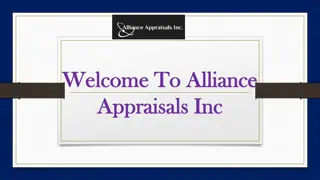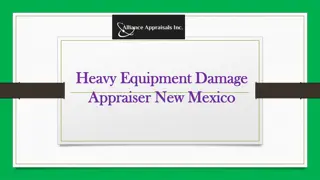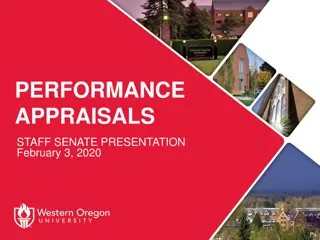Understanding Performance Management and Appraisals in the Workplace
Performance management and appraisals are crucial processes for evaluating employees' performance, setting work standards, providing feedback, and facilitating career planning. This involves assessing employees' performance relative to set standards, identifying training needs, and aligning individual and team performance with organizational goals. Various methods such as peer appraisals, rating committees, and self-ratings are used for appraisals. Effective performance management involves continuous feedback and coaching to improve performance.
Download Presentation

Please find below an Image/Link to download the presentation.
The content on the website is provided AS IS for your information and personal use only. It may not be sold, licensed, or shared on other websites without obtaining consent from the author. Download presentation by click this link. If you encounter any issues during the download, it is possible that the publisher has removed the file from their server.
E N D
Presentation Transcript
Performance Management & Appraisals Lecture 11
Performance Appraisal Performance employee s current and/or past performance relative to his or her performance standards. Performance appraisal always involves the 3-step performance appraisal process: (1) setting work standards; (2) assessing the employee s actual performance relative to those standards (this usually involves some rating form); and (3) providing feedback to the employee with the aim of helping him or her to deficiencies or to continue to perform above par. appraisal means evaluating an eliminate performance
Why Performance appraisal? There are five reasons to appraise subordinates performance. First, most employers consider base pay, promotion, and retention decisions on the employee s appraisal. Second, appraisals play a central role in the employer s performance management process. Performance management means continuously making sure that each employee s and teams performance makes sense in terms of the company s overall goals. Third, the appraisal lets you and the subordinate develop a plan for correcting any deficiencies, and to reinforce the things the subordinate does right. Fourth, appraisals should facilitate career planning. They provide an opportunity to review the employee s career plans in light of his or her exhibited strengths and weaknesses Finally, supervisors use appraisals to identify employees training and development needs. The appraisal should enable the supervisor to identify if there is a performance gap between the employee s performance and his or her standards. And it should help identify the cause of any such gap, and the remedial steps required.
Performance Management It is the continuous process of identifying, measuring, and developing the performance of individuals and teams and aligning their performance with the organizations goals. A system that involves employee evaluations once a year without an ongoing effort to provide feedback and coaching so that performance can be improved is not a true performance management system. Performance management systems that do not make explicit the employee organizational goals are management systems. contribution not true to the performance
Who Should Do the Appraising? PEER APPRAISALS With more firms using self- managing teams, appraisal of an employee by his or her peers peer-appraisal is popular. RATING COMMITTEES A rating committee is usually composed of the employee s immediate supervisor and three or four other supervisors. SELF-RATINGS Some employers obtain employees self-ratings, usually supervisors ratings. The basic problem, of course, is that employees usually rate themselves higher than do their supervisors or peers. in conjunction with
Who Should Do the Appraising? APPRAISAL BY SUBORDINATES Many employers have subordinates rate their managers, usually for developmental rather than for pay purposes. Anonymity affects the feedback. Managers who receive subordinates who identify themselves view the upward feedback process more positively. However, subordinates prefer giving anonymous responses (not surprisingly), and those who must identify themselves tend to give inflated ratings. feedback from
Who Should Do the Appraising? 360-DEGREE FEEDBACK With 360-degree feedback, the employer collects performance information all around an employee from his or her supervisors, subordinates, peers, and internal or external customers generally for developmental rather than pay purposes. The usual process is to have the raters complete online appraisal surveys on the ratee. Computerized systems then compile all this feedback into individualized reports to ratees. The person may then meet with his or her supervisor to develop a self- improvement plan.
TECHNIQUES FOR APPRAISING PERFORMANCE Some popular techniques are: Graphic Rating Scale Method Alternation Ranking Method Paired Comparison Method Critical Incident Method Narrative Forms Computerized and Web-Based Performance Appraisal
Graphic Rating Scale Method A graphic rating scale lists traits or performance dimensions (such as communication or teamwork ) and a range of performance values (from below expectations to role model or unsatisfactory to outstanding, ) for each trait. The supervisor rates each subordinate by circling or checking the score that best describes the subordinate s performance for each trait. The manager then totals the assigned ratings for the traits.
Alternation Ranking Method Ranking employees from best to worst on a trait or traits is another option. Since it is usually easier to distinguish between the worst and best employees, an alternation ranking method is most popular. First, list all subordinates to be rated, and then cross out the names of any not known well enough to rank.
Paired Comparison Method The paired comparison method helps make the ranking method more precise. For every trait (quantity of work, quality of work, and so on), you pair and compare every subordinate with every other subordinate. Suppose you have five employees to rate. In the paired comparison method, you make a chart, of all possible pairs of employees for each trait. Then, for each trait, indicate (with a -or +) who is the better employee of the pair. Next, add up the number of -s for each employee. In Figure, Maria ranked highest (has the most - marks) for quality of work, whereas Art was ranked highest for creativity.
Critical Incident Method With supervisor keeps a log of positive and negative examples (critical incidents) of a subordinate s work-related behavior. Every 6 months or so, supervisor and subordinate meet to discuss the latter s performance, using the incidents as examples. the critical incident method, the
Narrative Forms Here the person s supervisor assesses the employee s past performance and required areas of improvement. narrative assessment aids helps the employee understand where his or her performance was good or bad, and how to improve that performance. The supervisor s
Computerized and Web-Based Performance Appraisal These computerized notes on subordinates during the year, and then to merge these with ratings for each employee on several performance traits. The software then generates written text to support each appraisal. enable managers to compile
Potential Appraisal Problems UNCLEAR STANDARDS It would probably result in unfair appraisals, because the traits and degrees of merit are ambiguous. For example, different supervisors might define good performance, fair performance, and so on differently. The same is true of traits such as quality of work or creativity. The best way to fix this problem is to include descriptive phrases that define or illustrate each trait. This specificity results in more consistent and more easily explained appraisals.
Potential Appraisal Problems HALO EFFECT Experts define halo effect as the influence of a rater s general impression on ratings of specific ratee qualities. For example, supervisors often rate unfriendly employees lower on all traits, rather than just on gets along well with others. Being aware of this problem is a step Supervisory training can also alleviate the problem. toward avoiding it.
Potential Appraisal Problems CENTRAL TENDENCY Some supervisors stick to the middle when filling in rating scales. For example, if the rating scale ranges from 1 to 7, they tend to avoid the highs (6 and 7) and lows (1 and 2) and rate most of heir people between 3 and 5. Central tendency means rating all employees average. Doing so distorts the evaluations, making them less useful for promotion, salary, or counseling purposes. Ranking employees instead of using graphic rating scales can reduce this problem, since ranking means you can t rate them all average.
Potential Appraisal Problems LENIENCY OR STRICTNESS Other supervisors tend to rate all their subordinates consistently high or low, just as some instructors are notoriously high or low graders. This strictness/leniency problem is especially severe with graphic rating scales. On the other hand, ranking forces supervisors to distinguish performers. There are other solutions. One is for the employer to recommend that supervisors employees high (or low) ratings. A second is to basically enforce a distribution that, say, about 10% of the people should be rated excellent, 20% good, and so forth. (But beware: Sometimes what appears to be an error such as leniency isn t an error at all, as when all subordinates really are superior performers.) between high and low avoid giving all their
Potential Appraisal Problems RECENCY EFFECTS The recency effect means letting what the employee has done recently blind you to what his or her performance has been over the year. The main solution is to accumulate critical incidents all year long. BIAS The appraisal often says more about the appraiser than about the appraisee. This is a powerful reason for using multiple raters.























